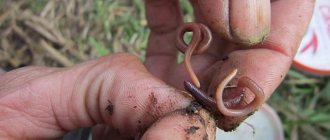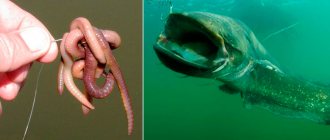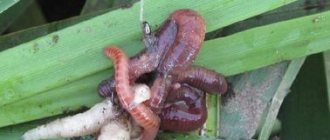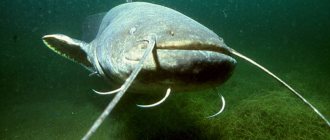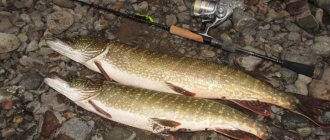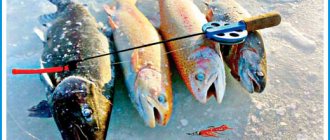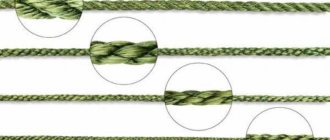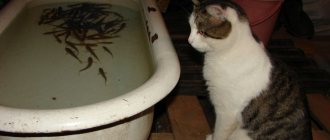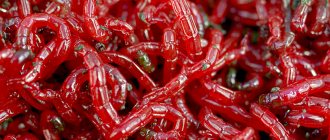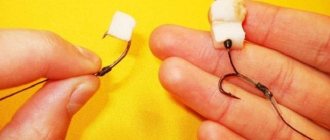What kind of worm is this and where does it live?
In appearance, dung beetles are very similar to ordinary earthworms. In most cases they are slightly longer. Unlike earthworms, dung worms emit a specific odor when hooked. At the same time, a little yellowish liquid is released. Dung worms can usually be found in manure or among wet, caked leaves.
Such worms are red-yellow or red-brown in color with small light stripes. He moves quickly. Dung worms live in colonies.
Even novice fishermen can grow worms for fishing at home.
Use for fishing, as bait and groundbait
When placed on a hook, a dung worm emits a characteristic odor that is very attractive to fish. This bait is especially loved by peaceful fish species, including crucian carp, roach, and bream. But perch and pike do not refuse either.
The worm is very mobile. Therefore, it is difficult to plant it accurately. However, this mobility is very attractive to fish. Particularly effective is the attachment in the form of a bunch of worms, which are able to maintain mobility for a long time.
Tench really like a sandwich of maggots and worms and in the spring in March-April it is the best bait when catching tench on a float
Preparing bait for bream fishing
Worms do not require special preparation before fishing - the main thing is to deliver the bait to the fishing site alive. For convenience, take with you a small table on which you can conveniently lay out not only attachments, but also additional accessories. It would not be amiss to use bait for bream: this fish is cautious and therefore it is important to attract it to the fishing site.
Important! If all aquatic inhabitants have stopped pecking (completely and permanently), add peas to the feeder to further attract fishing objects.
You can also use bait, since it is more effective even during the manifestation of negative natural factors, such as rain, strong wind or current. It is also capable of instilling in the fish the “habit” of feeding in the same place.
During fishing, unforeseen circumstances may occur: instead of bream, roach or other medium-sized fish are caught. Of course, some fishermen can be content with this, and when the bite is over, they can simply return home. However, the cessation of the appearance of other fish indicates that bream have swum to the feeding area.
How to get dung beetles - where to look, how to find, get and prepare for fishing
The dung worm avoids very dry or very wet places. It can often be found in abandoned greenhouses, compost pits, and heaps of manure. Such worms love places where there are plant remains or stale leaves. They are easy to assemble using a fork. This reduces the risk of damage.
You can also use the following method to search for a worm. Make a hole in the ground and place a piece of manure or some stale leaves in it. This place is moistened and covered with a sheet of cardboard. In a few days, dung worms will definitely appear here.
Once the worm is collected, it needs to be stored properly. Closed jars or boxes are suitable for it. They need to be lined inside. Moss or a mixture of clay and cake are suitable for this. To keep them mobile for as long as possible, beets or tea leaves are added to the jar. This method is intended for short-term storage, but is not suitable for long-term storage.
Worm boxes
Only moving specimens are suitable for fishing. Those that are not viable will not attract fish effectively.
How to breed dung worms, where, in what substrate, what to feed
Unfortunately, it is not always possible to dig up a worm. This, for example, is difficult to do in hot weather or for winter fishing. To always be able to use a dung worm, it is convenient to grow it yourself.
If you properly organize their breeding, then growing worms will not disturb the cleanliness of your home. To do this you need to use a suitable box. It can be made of wood or plastic. A cardboard box can also be used.
If you plan to grow worms constantly, one that is made of plastic is better suited.
It is not recommended to use metal containers, this is due to the fact that this material will enter into a chemical reaction with the soil that will be in it.
The dung worm is the most popular worm among anglers.
Sizes are selected as follows:
- The height should be approximately 30 cm;
- The area is selected based on the number of worms. To raise a thousand adult individuals, 1 square meter will be required. meter of area.
It is necessary to make small holes in the bottom for drainage, and in the side walls for ventilation. They need to be spaced evenly. The more holes are made, the better. Their diameter should be so small that worms cannot crawl through it.
The box is placed on a pallet with sand. At the same time, excess moisture will be absorbed, which will ensure cleanliness.
Special worm trap - a classic of worm farming
The bottom of the box must be lined with a layer of compacted hay or straw. Its thickness should be 5-6 cm. The container can be filled with purchased vermicompost or you can create a soil mixture yourself. In the latter case, you need to add chopped hay or straw mixed with sawdust and manure to the ground. The components must be thoroughly mixed and compacted.
You need to make sure that there is no ash from the fire in the soil you use. It has a detrimental effect on worms. You should also avoid the presence of fresh humus. It will rot, taking oxygen from the soil, which is vital for the worms.
The soil must have a normal acid-base reaction. To check it, it is convenient to use litmus paper. Each worm will require 300-400 grams of substrate throughout the year. Soil moisture should be moderate. If you squeeze it in your fist, moisture should only slightly appear.
After preparing the box with the substrate, worms are placed in it. You need to give them time to hide in the ground. When feeding, you need to take into account that in natural conditions, rotten plant remains serve as food. When grown at home, they can be given kitchen scraps, hay or fallen leaves. Fruit or vegetable peelings are suitable. It is not advisable to feed potatoes. Coffee or tea grounds and leftover cereal without milk are also suitable.
Potato peelings are not recommended for this purpose. Also, salty waste should not be given. Using leftover fish or meat will result in an unpleasant odor.
Worms prefer to eat the food they are used to. If you have to change it, you need to do it gradually. The food should be placed evenly over the entire surface of the layer box, the thickness of which is approximately 5 cm. It can be covered with a sheet of cardboard on top. After the food is processed, it is added again.
What to feed worms for rapid growth:
Suitable humidity must be provided for the worms. This requires regular watering. For this purpose, the water must be left to stand for at least three days. It should be at room temperature. Worms feel comfortable at a temperature of 18-24 degrees. The box should be placed in a dark place away from heating devices.
In two months the number of worms will double. In some cases, the increase can be significantly greater. Before they are resettled, feeding is stopped. After this, the worms are released to the surface, from where it will be more convenient to collect them.
Breeding dung worms at home - video training on how to select, breed and preserve worms in an apartment/private house:
Worms for fishing. Preparing a fish delicacy
In today’s article we will tell you about the tricks of preparing worms for successful fishing. What you need to add to the worms that are tasty and appetizing, so that the worms become in maximum demand by fish, so that bites happen more often, and the bite is better than other fishermen.
As you can see in practice, simply buying or digging up worms for fishing from a pile of dung and then going fishing is only 30% of bites. Worms must be cleaned before fishing. Ideally, the worms should be cleaned at least 12-24 hours before fishing. Using a jar of worms as an example, let them be red dung worms, we will tell you how to make one out of them. appetizing bait for fish, stuffing them with delicious filling. Then the worms will acquire a flavor that no fish can resist.
Worms are a tempting treat for most fish
For this you will need the following ingredients:
- A piece of cotton cloth, necessarily made of cotton;
- 2 gram packet of vanillin;
- 1 tablespoon sugar;
- melt water;
- Dried tea leaves, mint leaves, in addition to it you can use thyme, lemon balm, dill, nettle, valerian, anise. Ideally, the presence of the grass that grows near the reservoir where you are supposed to fish.
Advice: You should never put worms with soil in a glass container, especially in hot summer weather. Such dishes are ruinous for them, and you will be left without a bait or the worms will be lethargic and unattractive. The fish will not bite such bait every time.
The process of preparing worms must begin with cleaning them.
So then:
- Take a container, put sugar in it, add vanillin, moisten it a little, and mix thoroughly.
- We wet a cotton cloth with melt water, then squeeze it thoroughly.
- Lay down newspaper or paper. Using tweezers, we pull out live worms one at a time, clearing them of waste, in the amount necessary for fishing.
- On a prepared damp cloth, place a mixture of vanillin and sugar in the middle, rubbing in with a spoon so that it is saturated with aromas.
- We lay out the tea leaves, grass, worms, carefully wrap them, and put them in a box.
For 12 - 24 hours in this state, the worms for fishing will be in a sugar-vanilla feed with grass. This means that the bait for catching crucian carp, carp, bream and other fish will be saturated, become sweet, elastic, mobile, and will smell like grass.
Source
Published 02/15/2016 at 11:44
handf.mirtesen.ru
How to bait and catch
When catching small fish, the worm is placed completely on the hook. In this case, the tip must be completely closed. For large fish this condition is not necessary. The following methods can be used:
- When pierced lengthwise, the hook passes inside the worm.
- It can be cut into several parts and mounted sequentially.
- When using loops, the arthropod is pierced crosswise in several places so that it hangs from the hook.
- If you pierce the worm so that both holes are nearby, it will wriggle, attracting fish with its movements.
- If a hook with several stings is used, it can be attached to the fore-end.
- You can place a worm along the hook so that it extends a few millimeters onto the fishing line.
Different ways to put a worm on a hook
If the bait has been in the water for too long, it needs to be changed.
A large hook can be used to attach a bunch of worms
How to properly place a worm on a hook - visual photos and videos
How to use as bait
When using dung beetle as bait, you need to take into account that the worm is too large for many fish and easily crawls away from the bait site. To prevent this from happening, it must first be cut into pieces. This is done immediately before casting the bait.
When chopping, a lot of juice will be released. It does not need to be removed as it can attract fish. However, if it can over-moisten the bait mixture, then the worm scraps are placed on a cloth and lightly squeezed before adding.
You can feed it in a mixture with soil, but it is most effective to use the worm in a mixture with maggots, caster or bloodworms.
For standing water, light chernozem with gray clay or bentonite can be used as soil (in the proportion of 2 kg of soil to 400 grams of clay). When fishing on a river, it is more convenient to use clean clay.
Baits for catching crucian carp of animal origin: types, features, when to use
First, let's look at what types of animal bait for crucian carp are common:
- Worm. Timeless classic. It’s hard to imagine any float fishing without this bait. However, the earthworm has a fellow animal - the dung worm, which is “more successful” than its neighbor. This bait is suitable for beginners, since the worm is common; if you wish, it will not be a problem to dig the worm yourself from the shore or buy it at a fishing store. Can be used at any time of day or month of the fishing season.
- Maggot. Another of the three hits of float fishing. More suitable for smaller specimens, but has one huge advantage - “survival on the hook” , unlike a worm and bloodworms, maggots hold on quite tightly and can serve for a long time, which is especially useful when catching fast fish and will make life easier for beginners, since they often In them, fitting a new bait can be a problem. If you live far from the city and getting maggots is problematic, you can use the following advice. Take a piece of meat or fish. In the case of fish, you will need to remove the scales. Place them so that they do not disturb neighbors and are difficult to reach for cats and dogs. Make small cuts in them and leave for 3-5 days. After the specified period, you will receive ready-made maggots.
- Bloodworm. There are many anglers who believe that crucian carp should be caught only with bloodworms . There is a reason for this, since often this fish bites only on it. It is best to plant a large bloodworm over the head, this way it will remain viable longer. If it is small, then you can use the “sandwich” attachment method, which will be described below.
Important! Crucian carp is an extremely cautious fish. The bite takes a long time, at first the fish seems to suck the bait, which is a disadvantage when fishing with bloodworms, because it can happen that the crucian carp sucks out all the nutrition from the bloodworm, and you, perplexed, will get a transparent body. For the same reasons, when biting, it is worth hooking more sharply so that the crucian carp gets on the hook.
- Live bait. If you want to catch the approval of fellow hobbyists or break an old record, use it. The top fishing rod is best suited for fishing for crucian carp with live bait. Despite its size, it has a number of advantages: vitality and the same habitat as crucian carp. If you don’t have a top-smelting fish, you can also use small-sized crucian carp itself. Live bait fishing is best done in the spring and/or at night as this is a time when water temperatures are low and big crucian carp move higher up where topwaters make up the main diet of the big fish.
